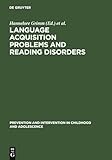Language acquisition problems and reading disorders : Aspects of diagnosis and intervention / ed. by Hannelore Grimm, Helmut Skowronek.
Material type: TextSeries: Prävention und Intervention im Kindes- und Jugendalter : Ein interdisziplinäres Projekt der Universität Bielefeld ; 14Publisher: Berlin ; Boston : De Gruyter, [2011]Copyright date: ©1993Edition: Reprint 2011Description: 1 online resource (360 p.)Content type:
TextSeries: Prävention und Intervention im Kindes- und Jugendalter : Ein interdisziplinäres Projekt der Universität Bielefeld ; 14Publisher: Berlin ; Boston : De Gruyter, [2011]Copyright date: ©1993Edition: Reprint 2011Description: 1 online resource (360 p.)Content type: - 9783110141207
- 9783110879575
- 618.92/855 20
- RJ496.L35 L348 1993eb
- online - DeGruyter
- Issued also in print.
| Item type | Current library | Call number | URL | Status | Notes | Barcode | |
|---|---|---|---|---|---|---|---|
 eBook
eBook
|
Biblioteca "Angelicum" Pont. Univ. S.Tommaso d'Aquino Nuvola online | online - DeGruyter (Browse shelf(Opens below)) | Online access | Not for loan (Accesso limitato) | Accesso per gli utenti autorizzati / Access for authorized users | (dgr)9783110879575 |
Browsing Biblioteca "Angelicum" Pont. Univ. S.Tommaso d'Aquino shelves, Shelving location: Nuvola online Close shelf browser (Hides shelf browser)
I-XII -- Part 1: Deficits in children with specific language impairment (developmental dysphasia) -- Metalinguistic difficulties in children with specific language impairment: Implications for diagnosis and intervention -- Syntax and morphological difficulties in Germanspeaking children with specific language impairment: Implications for diagnosis and intervention -- Commentary on Menyuk and Grimm: How well do we understand specific language impairment? -- Perceptual and cognitive deficits in children with specific language impairment: Implications for diagnosis and intervention -- Commentary on Ellis Weismer: How specific is specific language impairment? Some comments by a relative outsider -- Social consequences of specific language impairment -- Commentary on Rice: What do we know about the sequelae of socioemotional and cognitive consequences of specific language impairment? -- Specific language impairment as a problem of accessing language knowledge -- Commentary on Connell, Franks and Stone: A context and some implications -- The relationship between speech-language impairments and reading disabilities -- Commentary on Catts: How to characterize continuity between preschool language disorders and reading disorders at school age -- Part 2: Disorders of written language (developmental dyslexia) -- Implications of the Pittsburgh Study for issues of risk -- Commentary on Perfetti, Georgi and Beck: Children without phonemic awareness before learning to read. Are they at risk? -- Prediction of difficulties in reading and spelling on the basis of the Bielefeld Screening -- Commentary on Marx, Jansen, Mannhaupt and Skowronek: The Bielefeld Screening Battery to predict reading and spelling difficulties -- Two small longitudinal studies: I. Developmental dyslexia II. Early reading development -- Commentary on Ellis: Two conceptually-rich longitudinal studies -- Emerging literacy from kindergarten to second grade: Evidence from the Munich Longitudinal Study on the Genesis of Individual Competencies -- Interventions in developmental reading and spelling disorders -- Commentary on Scheerer-Neumann: Organizing the literature on interventions for reading and writing disabilities
restricted access online access with authorization star
http://purl.org/coar/access_right/c_16ec
Issued also in print.
Mode of access: Internet via World Wide Web.
In English.
Description based on online resource; title from PDF title page (publisher's Web site, viewed 29. Jun 2022)









